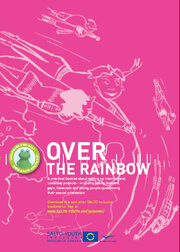Specifics of International LesBiGay Projects
- Find this and more in the SALTO Inclusion for All booklet: Over the Rainbow
- Besides the specifics of LesBiGay projects below, you can find inspiration for your programme of activities in the SALTO Toolbox for Youth Work and Training at www.SALTO-YOUTH.net/Toolbox/: get-to-know games, simulation games, group methods, energisers, exercises addressing social in/exclusion and discrimination,...
Specifics of the target group
Coming-out
"Coming-out of the closet" is the term commonly used to describe when a homosexual openly states his or her homosexuality to parents, peers, employers, etc. Because of personal insecurity and the fear of negative reactions, homophobia it can be a long and difficult process before a LesBiGay young person decides to do their 'coming out', first to themselves (by accepting and acting on their feelings) and then to others. 'Coming-out' is a very personal issue, with many steps involved. Some young people come out first of all to their friends, and only after some years to their parents and others, and to some they'll never tell (grandparents, employers,...). Other people decide to come out to everyone at the same time.
The question of 'coming-out' is important when organising an activity with and for young LesBiGay people. Many young people, though actively involved in LesBiGay youth organisations are not necessarily 'out'. They may feel comfortable in the company of other LesBiGay peers, however this doesn't necessarily imply that they feel ready to come out to other people outside of this closed circle. It is a personal decision that every gay man or woman must take for themselves and this process should not be rushed.
- More about Coming-Out in "Different in more ways than one. Providing guidance for teenagers on their way to identity, sexuality and respect" www.diversity-in-europe.org (tips for youth workers and counsellors working with LesBiGay youth, background information, exercises, FAQ, stories, etc.)
It may be possible that some participants in your international activity are not 'out' yet. Therefore, it is important to make sure when planning the activity that those young people are not "outed" by accident (e.g. by putting the group's picture in the local newspaper after a youth exchange, by circulating names or address lists without asking, making information available on the Internet, etc.). You also need to take special care about how you promote or describe the project, e.g. if you ask parents to allow their son or daughter to take part in a 'homosexual project' it may provoke a more negative reaction than would be the case if the project was described as 'a cultural project against discrimination'.
You should bring up this issue in the preparation phase of your project and ask participants to reflect on this question and come up with some suggestions on how to deal with this issue. You could have a more neutral project description for people outside your organisation and a rainbow coloured one for your own members. You might decide to use nicknames for participants during the project (i.e. in address lists) and blend out faces on photos to show to others the difficulties some young people face in coming out. The same topics would more than likely have to be discussed also with the partner organisation.
^^ top ^^
Creating a safe & supportive environment
LesBiGay young people are similar to any other group of adolescents. They are creating their identities by finding their place in a group and in society. This issue is all the more sensitive if the question of their sexual orientation and identity is not cleared out yet, or if it causes additional stress in their lives, at school, with their parents, families or friends. They might have experienced bullying or harassment in school, or might feel an overwhelming pressure from parents, friends and society to adhere to the norms of society, to refrain from expressing their feelings or emotions and as a result might feel vulnerable in groups.
Youth workers have a role to play in creating a safe and supportive environment for these young people. They can stimulate group dynamics by proposing activities in which the young people get to know each other better, in which they will need to co-operate or discuss or in which they have fun together, e.g. group discussions on specific topics, an outing to an amusement park, undertaking fundraising activities together, etc. The youth worker should take care of the needs and sensitivities of the group and ask young people to respect these, e.g. reject abusive language, avoid excluding members of the group, create a space in which sensitive issues can be discussed, etc. A climate of dialogue and respect is beneficial to the wellbeing of the young people.
International projects involve expanding our limits by challenging ourselves and discovering how we react to new situations. This, however, should not be an excuse to force young people to do things they don't feel comfortable with. The rest of the group might feel happy doing street theatre or marching for LesBiGay rights, but some young people might not. It is up to the youth worker to protect individuals from peer pressure and to give everybody the possibility to opt out.
It is important to debrief emotional activities that some participants may have difficulties with e.g. speaking in front of a class, showing affection to someone of the same gender in public, etc. There needs to be a time and a space to discuss misunderstandings, friction and frustrations. You can decide to do this on a one-to-one basis, or in smaller groups which could be mixed or based on a common characteristic (e.g. gender, nationality, sexuality) or in whatever form is most comfortable for the participants. Talking can defuse many conflicts and problems.
^^ top ^^
Relations within the group(s)
It would not be the first time that the gay guys complain about 'the lesbians' or that the bisexuals are told to 'make up their minds'. The LesBiGay community could be regarded as a rainbow of different groups, and these groups don't necessarily get along just because they all happen to be "not heterosexual". Many young LesBiGay people hold prejudices against other LesBiGay subgroups.
During an international youth project, where there are young lesbians, gays and bisexuals living, working and having fun together almost 24 hours a day, tiredness can kick in and tensions can surface. At such moments it is very tempting to start complaining about 'the gay guys' or 'the lesbians', or similarly about the group from a certain country, especially if there are unbalanced proportions of one or the other group. It is important to put aside enough free time in your project to digest and rest.
It is important to create a good atmosphere where the different groups, be it different nationalities, different genders or different sexualities, can interact in a pleasant and respectful manner. For certain elements in your programme, e.g. sexual health, young gays might have more to share with each other than with the lesbian girls. For this reason it might be wiser to hold discussions apart. On the other hand, the different groups might also learn from one another, e.g. associative life, anti-discrimination, etc. Ensure that your programme has a mixture of opportunities to bring different nationalities and people with different sexual orientations together as well as opportunities for discussion between like-minded people. When tensions mount between groups it is important to diffuse them quickly.
^^ top ^^
Sharing rooms
Traditionally, in order to avoid intimate contacts between the young participants in a youth project, males and females do not share rooms. When dealing with a LesBiGay youth group this traditional solution is not valid. What's the alternative?
Instead of avoiding the question of sexual relationships during an exchange, presumably solved by splitting up the boys from the girls, the question should, on the contrary, be addressed. Unless you have the finances available to provide each participant with a single room, there is no other option but to have the young people share a room with someone. This could be a basis for a direct and frank discussion with the participants about relationships and responsibilities, about safe sex and clever behaviour. This could lead to a code of conduct, signed by all (if you think it necessary or useful).
- More about sexual health and relationships at www.lgbtyouth.org.uk (under Support) or www.gay.com/health/ or on many other LesBiGay sites
Ideally the partner organisations should work towards a shared code of conduct. It could be very interesting to compare the various codes of conduct of the different partner organisations (both the organisations' policies AND the young people's views). What are the similarities and differences between the suggested codes and why? Some organisations may come up with a list of forbidden behaviour, while others simply list what is allowed. The penalties imposed when breaking the rules can vary. Are there cultural aspects that might influence these differing approaches?
^^ top ^^
To be or not to be ... of age
Young people that are underage (under 18 in most European countries) need the authorisation, sometimes in writing, of their parents or legal guardians in order to participate in an international youth project. In this instance the youth worker has a lot more responsibility in relation to the young people than if they were 18 and older and participated in the project as young adults. Underage participants have wider implications than this however.
It might be the case that underage participants are 'not out' to their parents. This makes it more difficult when asking the young participants to have their parents sign a declaration of consent in order to be legally allowed to go on an international project under the care of the youth organisation. It would be bad practice to lie about the project (parents usually find out anyway!), but you could opt to give your project an innocuous name that wouldn't shock the parents e.g. Art against discrimination, Alternative youth cultures, etc.
Even if the underage participants are 'out' to their parents, they still might have many doubts about allowing their son or daughter participate because of a fear of the 'sexual freedom' their child might be exposed to abroad, or because of doubts about the organisation or its leadership. The youth workers have a vital role to play in the way they present the project so that parents are encouraged, by the quality and seriousness of the undertaking, to allow their children benefit from this international opportunity.
- more about the benefits of a LesBiGay projects here - you could use these as an aid in convincing parents to allow their son or daughter participate in the project
Find out about the fears parents have that prevent them from allowing their son or daughter participate in an international project and provide them with sufficient information and guarantees on how you will deal with any dubious situations that may arise. You could perhaps share with them the code of conduct that you agreed with the potential participants of the project. The parents might also be interested to know about the experiences and qualifications of the youth workers that will be coordinating the project. These can be provided easily. You can keep them informed about, or even involve them in, the preparation of the project so that they know exactly what is going on and how the project is being managed. Parents can, over time, come to understand the rationale behind the project, appreciate the benefits it holds for their own son or daughter and overcome their reluctance to participate. It can, however, take a lot of time and work to convince them.
^^ top ^^
Downloads
The following downloads are available:
- Over the Rainbow - international LesBiGay projects - 2008 update
Inspiration & advice for setting up respectful projects with young gay lesbian bisexual people. Lots of information about project management, finding partners, funding,... Based on SALTO TC Rainbow 2005


